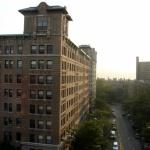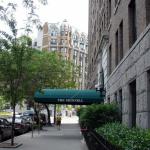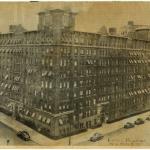 | ||||
 | ||||
The Grinnell
(click to enlarge)
 | ||||
Among the new buildings which have been erected in Riverside Drive is the Grinnell, a nine story structure, which occupies a portion of old Audubon Park. The building is triangular, having frontages in the drive, Audubon place and 157th Street, two entrances being provided, one in each of the two first named streets. The building is named after the Grinnell family, which once owned the ground, and will be ready for occupancy shortly. Owing to Riverside Drive and Broadway practically converging at this point the Grinnell holds a strategic position.
As laid out by the Centre Realty Company, the owner and builder, all the principal rooms face in one of the named streets, while in several of the suites the large majority of the rooms have outside exposure. The building differs from almost every other apartment house structure, inasmuch as in almost every building erected on the regulation square corner plot the smaller suites are almost invariably located in the rear of the house.
The central court of the Grinnell is finished in faced brick, limestone and terracotta and in design and appointment treated in a manner at once simple, imposing and attractive. Owing to the width of the court the rooms , which have outlet into it, are as light as those facing in ordinary streets.
The building is laid out with ten apartments on each floor containing from five rooms and bath to nine rooms with three baths. On the entrance and first floors there are several duplex apartments containing seven and nine rooms each.
New York Herald
June 4, 1911
The Grace
(click to enlarge)
Grinnell Entrance on Riverside Drive
(click to enlarge)
The Grinnell (800 Riverside Drive)
The Riviera enjoyed her position as queen of Audubon Park for only a few months before the completion of the Grinnell, in July 1911. Although it is four stories shorter, and its cost was only $600,000, less than half the Riviera’s pricetag, the Grinnell possesses ample majesty of her own. Sitting on higher ground than the Riviera, her nine stories rise from a triangular block like an imposing fortress, towers on each corner extending her height another two stories. Instead of a moat, three streets set her off from the rest of the neighborhood, both physically and psychologically. This triangular lot, by the way, was once the Grinnell’s cow pasture.
Do you remember the leaf-and-berry motif from Rhinecleff Court? Here it is again, around the two story arched entrance of the Grinnell. An popular tale suggests that when the Grinnell was new, the entrance on Edward M. Morgan Place was the pedestrian entrance and this was the vehicular entrance, though the heavy granite sill and limited space for turning a vehicle in the courtyard would have made that impossible. A long passageway at this entrance, which leads into a central courtyard, cuts through apartment lines on both the first and second floors. To accommodate the grand entrance, Schwartz and Gross combined the interrupted lines into duplexes, one on either side of the archway. A few paces further up Riverside Drive is the entry to a third duplex apartment; this one with an exterior entrance.
When it was new, the Grinnell featured many of the standard amenities, with layouts “designed to meet the requirements of those accustomed to private houses” and “rentals 30% less that the Middle West Side.” Until World War II, the Grinnell had uniformed staff, twenty-four hour elevator service, and mail delivery to apartment doors – twice a day. Every apartment had a dumbwaiter so that deliveries could be made through the rear entrance and basement. The dumbwaiters also served to transport rubbish and soiled clothes to the basement, which contained a building-operated laundry. Until recently, large drying racks remained as a reminder of those days. Stories passed on by early residents report that the Grinnell’s management gave dances for the residents every spring – on the roof, with a full orchestra.
An interesting foot-note to the Grinnell’s history: In the late 1940s, Daddy Grace, an evangelist noted for his flamboyant appearance – he painted his fingernails red, white, and blue and favored cut-away coats and flowing hair – purchased the Grinnell in the name of the Church of the House of Prayer for All People, which he had founded. Daddy Grace took great pride in his new acquisition, featuring it on the cover of his magazine "The Grace," and, according to local residents, came monthly in his limosine to collect rents and check on the buidling. Some also remember that he rechristened 800 Riverside Drive, "The Grace," though no records confirm that name change.
For more information about the Grinnell, visit the building's centennial website: The Grinnell at 100.
Continue your walk . . .
Funded by the Audubon Park Alliance


